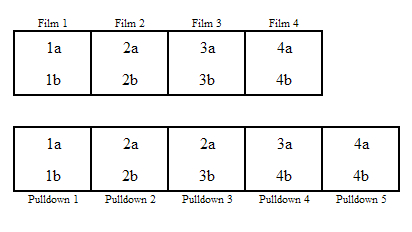Pulldown
Pulldown is a technique for flagging Progressive video for display on interlaced displays. Pulldown flags, which are most commonly found in MPEG-2, MPEG-4 AVC (H.264), and VC-1 video streams, are generally used to instruct the video decoder to repeat every other line (a complete field) in each progressive Frame to produce output that matchs either a PAL or NTSC television system.
2:3 Pulldown
The most common pulldown pattern, 2:3 Pulldown (also called 3:2 Pulldown), is actually based on the standard method for transferring 24fps film to NTSC video tape. Because NTSC's Framerate is 29.97fps (30 / 1.001) the film is slowed to 23.976fps (24 / 1.001) and then half of every other frame is duplicated, or shown for twice as long as normal. This results in enough extra fields to exactly reach NTSC framerate. Rather than storing fields more than once, film based sources can be stored in their original progressive form with 2:3 Pulldown flags instructing the decoder to create duplicate fields on the fly. This generally results in higher quality video encodes, as well as better results from some progressive scan DVD players.

2:2:2:2:2:2:2:2:2:2:2:3 Pulldown
A 2:2:2:2:2:2:2:2:2:2:2:3 Pulldown pattern is used to convert 24fps film based content to 25fps PAL video. However, most professionals favor simply speeding up the film by 4% to perform this conversion. Unlike using Pulldown, it results in the original progressive frames being displayed all the time and uses only slightly higher Bitrate for similar quality.
2:2 Pulldown
While 2:2 Pulldown could be used to simply tell a video decoder to convert progressive frames to interlaced fields for display, this is a standard automatic feature for most decoders to perform without the presence of flags. There are no consumer tools for adding 2:2 Pulldown Flags.
2:2:3:2:3 Pulldown
Although 2:3 and 2:2 are standard Pulldown patterns, the video decoders found in standalone DVD players, as well as those used by software players, are capable of handling any number of pulldown patterns. It's simply a matter of adding the PROPER flags into the video stream in the proper places. One program, DGPulldown, is capable of doing this. The most common use for these non-standard flags is converting 25fps progressive PAL video to 29.97fps interlaced NTSC. By using a 2:2:3:2:3 Pulldown pattern, and not duplicating an occasional Field to maintain the correct timing, DGPulldown can make a MPEG-2 file encoded at 25fps and a Resolution of 720x480 legal for a NTSC DVD. While there may be some standalone players that won't handle this properly, that's a limitation of the manufacturer's Firmware, rather than the MPEG decoding hardware.
2:3 vs. 3:2
Although more people seem to refer to it as 3:2 pulldown, the standard implementation for any Pulldown pattern is to duplicate frames as late in the sequence as possible without changing the pattern. In other words, 3:2 Pulldown would result in 1 original frame followed by 2 made up of fields from different frames. By using a 2:3 pattern instead you start with two original field pairs before the two combined frames. This also holds true for 2:2:3:2:3 Pulldown, which could just as easily be 3:2:3:2:2.
Software For Adding Pulldown Flags
For adding Pulldown flags to MPEG-2 you can use DGPulldown. It supports standard 2:3 Pulldown, as well as a variety of other patterns including 2:2:3:2:3. You can find more information plus a download for DGPulldown on Donald Graft's website. Although Pulldown flags are supported in AVC video, there are no consumer tools currently available for adding them.
Related Guides:
Digital Video Fundamentals - Frames & Framerates

